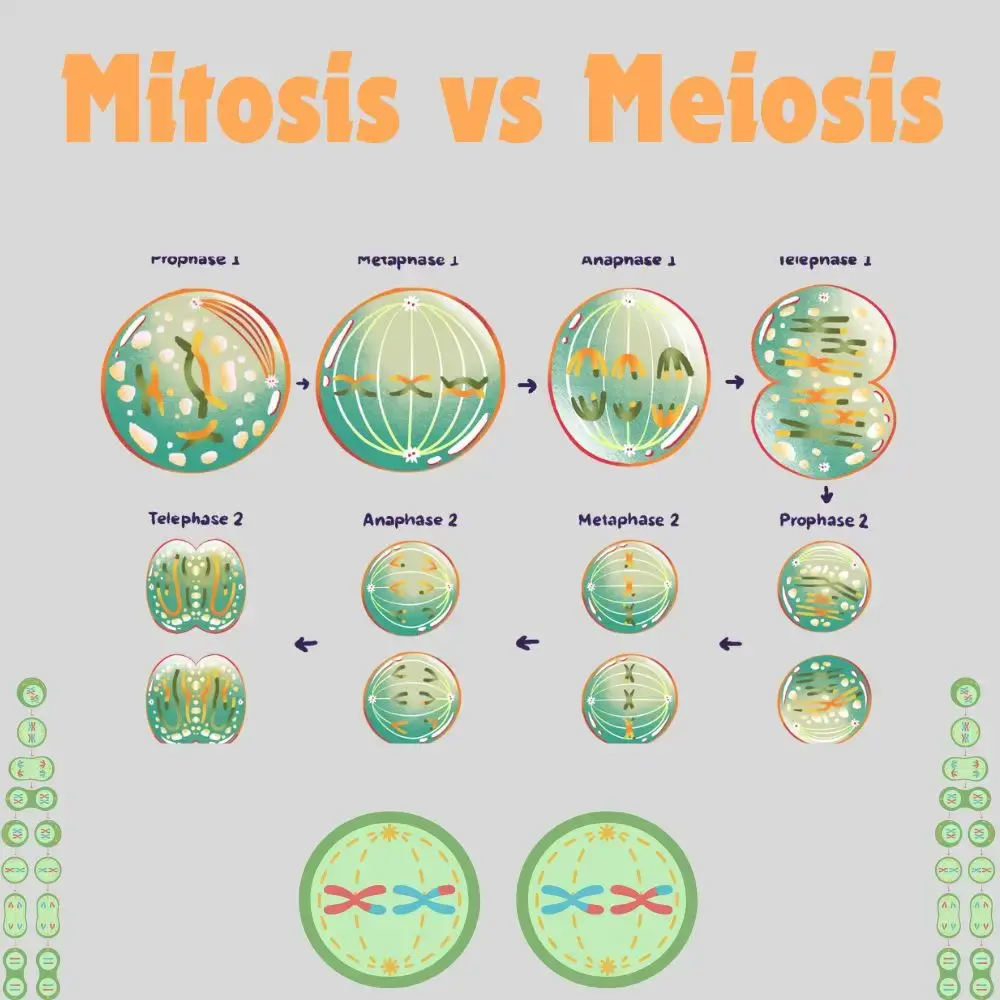Mitosis and meiosis are two fundamental processes of cell division in living organisms. Mitosis is responsible for the growth and maintenance of an organism by creating identical copies of cells, ensuring that each new cell has the same number of chromosomes.
Purpose and Function of
Mitosis and meiosis serve distinct but crucial purposes in the life cycle of organisms.
1.Mitosis: is primarily responsible for growth, tissue repair in eukaryotic cells. Through mitosis, a single cell divides to produce two genetically identical daughter cells, ensuring that the organism can grow and replace damaged or worn-out cells.
2.Meiosis: is essential for sexual reproduction, reducing the chromosome number by half to produce gametes (sperm and eggs) in diploid organisms. This reduction is crucial for maintaining the stability of the species’ chromosome number across generations and for introducing genetic diversity through recombination and independent assortment, which are key processes in evolution .
Process and Stages
Mitosis and meiosis are essential processes of cell division with distinct stages.
1.Mitosis: involves one division cycle and is primarily responsible for growth and repair. It includes several stages: prophase (chromosomes condense), metaphase (chromosomes align at the cell’s equator), anaphase (sister chromatids separate), and telophase (chromosomes decondense and the cell splits).
2.Meiosis: crucial for sexual reproduction, consists of two division cycles (meiosis I and II), reducing the chromosome number by half. Meiosis I includes prophase I (homologous chromosomes pair), metaphase I, anaphase I, and telophase I. Meiosis II resembles mitosis, with prophase II, metaphase II, anaphase II, and telophase II occurring in each of the two cells produced by meiosis.
Genetic Outcomes
The genetic outcomes of mitosis and meiosis differ significantly due to their distinct roles in cellular processes.
1. Mitosis: results in two genetically identical daughter cells, each with the same number of chromosomes as the original cell, ensuring consistency in genetic information across somatic cells. This process is crucial for growth, repair reproduction.
2.Meiosis: produces four genetically diverse daughter cells, each with half the number of chromosomes compared to the brood cell. This reduction in chromosome number is essential for sexual reproduction, as it maintains genetic diversity and ensures that offspring inherit a combination of traits from both parents.
Biological Significance
Mitosis and meiosis are vital cellular processes with distinct biological significance.
1.Mitosis: is crucial for growth, development, and tissue repair in multicellular organisms. It ensures that new cells have the same genetic material as the brood cell, maintaining genetic stability across somatic cells.
2. Meiosis: is essential for sexual reproduction, reducing the chromosome number by half to produce gametes—sperm and eggs. This reduction is necessary to maintain the species’ chromosome number across generations and promotes genetic diversity, which is crucial for evolution and adaptation.
Key Differences
Mitosis and meiosis are two types of cell division, but they serve different purposes and produce different outcomes.
1.Mitosis: results in two genetically identical daughter cells, maintaining the same chromosome number as the parent cell. It is essential for growth, tissue repair reproduction.
2.Meiosis: on the other hand, produces four genetically diverse sex cells (gametes), each with half the chromosome number of the parent cell. This reduction is critical for sexual reproduction and ensures genetic variation in offspring.
How Meiosis Contributes to Evolution and Genetic Variation
Meiosis is essential for generating genetic diversity, which is a cornerstone of evolution. It achieves this through two primary processes: independent assortment and genetic recombination. During meiosis, homologous chromosomes are distributed randomly into gametes through independent assortment, creating a wide array of genetic combinations.
Additionally, genetic recombination, or crossing over, occurs when homologous chromosomes exchange segments, resulting in new allele combinations. These mechanisms ensure that each gamete—and thus each offspring—has a unique genetic profile. This genetic variation provides the raw material for natural selection to act upon, enabling populations to adapt and evolve over time.
What are the similarities?
Mitosis and meiosis are both processes of cell division that share several similarities. Both occur during the M-phase of the cell cycle and involve the division of a parent cell’s nucleus.
Additionally, both processes ensure the proper distribution of chromosomes to daughter cells, using similar stages such as prophase, metaphase, anaphase, and telophase. In both mitosis and meiosis, spindle fibers are responsible for separating the chromosomes or chromatids, and cytokinesis ultimately divides the cytoplasm to form new cells.
Acknowledgments of mitosis vs meiosis
Acknowledging the processes of mitosis and meiosis involves recognizing their fundamental roles in the development and continuity of life. Mitosis ensures the production of genetically identical cells for growth, repair, and asexual reproduction, while meiosis is crucial for sexual reproduction and genetic diversity through the formation of gametes.
These two processes are essential for the survival of organisms and maintaining genetic stability across generations. Research in these areas continues to enhance our understanding of cellular biology and the mechanisms that govern life itself.
The Importance of Mitosis and Meiosis in Living Organisms
Mitosis and meiosis are fundamental processes for the growth, development, and reproduction of living organisms. Mitosis is crucial for asexual reproduction, cellular growth, and repair, as it produces genetically identical cells necessary for tissue regeneration and organismal development from a single-cell zygote to a fully developed individual. interphase, during which the cell’s DNA duplicates, is critical for both mitosis and meiosis, while centromeres ensure proper chromosome segregation in both processes .
On the other hand, meiosis is essential for sexual reproduction and genetic diversity. It reduces the chromosome number by half to produce haploid gametes, ensuring that when fertilization occurs, the diploid chromosome number is restored. Additionally, meiosis introduces genetic variation through processes like crossing over and independent assortment, which are crucial for evolution and adaptation. Mitosis replicates a cell to produce two identical and two daughter cells, while meiosis generates four cell and non-identical germ cells through two rounds of division.
